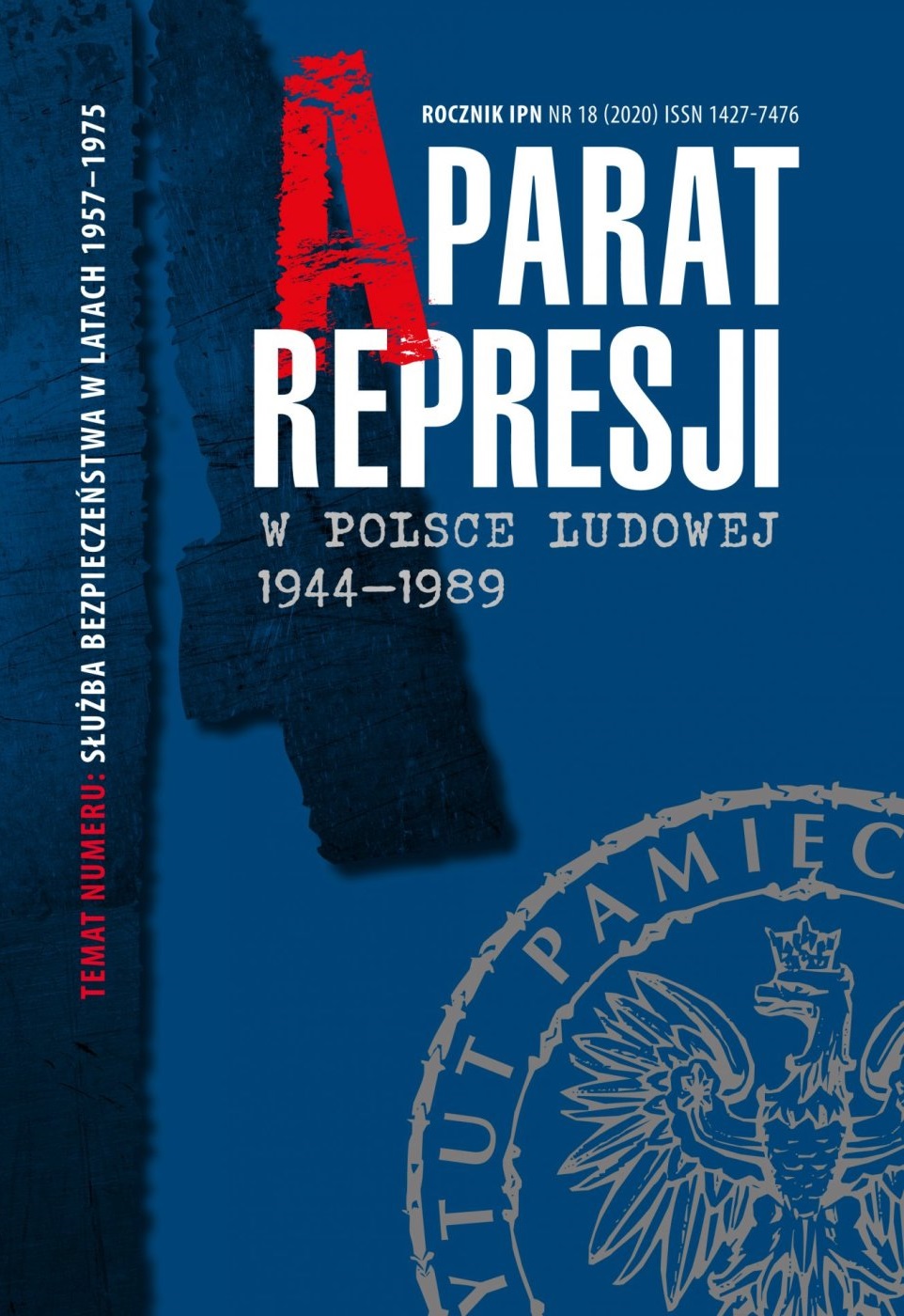The Activities of Regional Censorship Offices under Martial Law in Poland
Aparat Represji w Polsce Ludowej 1944-1989, No. 18 (2020), pages: 516-593
Publication date: 2023-03-29
 https://doi.org/10.48261/ARPRL201819
https://doi.org/10.48261/ARPRL201819
Abstract
The article presents the activities of regional censorship offices operating at voivodeship level during the Martial Law in the 1981–1982. Those were created out of personnel from Sections W and Sections T of the Voivodeship Citizen’s Milicia Headquarters and Voivodeship Offices of Internal Affairs (KWMO/WUSW) and operated for over a year (13 December 1981 to 31 December 1982). The main task of those regional censorship offices was to censor mail correspondence and telecommunications messages, and to provide surveillance of telephone calls. The article is based on the Security Service sources relating to postal censorship and reports on the telecommunications censorship activities of individual regional censorship offices. The article looks at the activities of the censorship offices in two sets of voivodeships created by the administrative reforms of 1975: the first set comprises the 17 previously existing (“historical”) voivodeships, the second one comprises the 32 extra voivodeships created as a result of the reform. A comparative analysis of the activities of different offices shows that the censorship of telecommunications messages and phone call surveillance were first handled (until the end of December 1981), and then only supervised, by Section T operatives. The burden of censoring telegrams and telex messages and conducting phone call surveillance fell to regular telecommunications workers. According to the heads of the relevant censorship sections this resulted in a drop in the quality and effectiveness of the censorship and produced inferior outcomes. The leadership of the Main Censorship Office believed that censorship fulfilled its intended role as a major constraint imposed across a broad spectrum of society. By censoring mail correspondence it was possible to gauge the public mood and opinions in different social groups (students, academics, culture) on the state of martial law as well as on government and party policies. The censorship also helped to curb the activities of the dissident opposition through seizure of clandestine publications published in Poland and abroad, and exerted a psychological impact on society, who kept hearing the recorded message, "this phone call is being monitored").
Keywords
cenzura listów • Wojewódzkie Urzędy Cenzury • cenzura telekomunikacyjna • kontrola rozmów telefonicznych • stan wojenny censorship of mail correspondence • Regional Censorship Offices at voivodeship level • censorship of telecommunications messages • phone call surveillance • Martial Law in Poland
References
Archiwum Instytutu Pamięci Narodowej w Warszawie (AIPN)
Instrukcje pracy pionów pomocniczych Urzędu Bezpieczeństwa i Służby Bezpieczeństwa (1945–1989), oprac. M. Komaniecka, Kraków 2010
Polskie Radio i Telewizja w stanie wojennym, oprac. S. Ligarski, G. Majchrzak, Warszawa 2011
Terenowe organy administracji i rady narodowe po reformie, red. naukowa J. Służewski, Warszawa 1977
Cenzura w PRL. Analiza zjawiska, red. Z. Romek, K. Kamińska-Chełminiak, Warszawa 2017
Gawryszewski A., Ludność Polski w XX wieku, Warszawa 2005
Gołębiewski E., Postęp techniczny w historii telekomunikacji polskiej (lata 1920–1995), Warszawa 2005 (opracowanie dostępne na stronie: www.sit.org.pl, dostęp 11 VII 2019 r.)
Internowani i uwięzieni w stanie wojennym, red. T. Kurpierz, J. Neja, Katowice–Warszawa 2018
Jusupović A., Organy bezpieczeństwa państwa w dokumentacji MSW. Próba systematyki [w:] Historyczno-prawna analiza struktur organów bezpieczeństwa państwa w Polsce Ludowej (1944–1990). Zbiór studiów, red. A.Jusupović, R. Leśkiewicz, Warszawa 2013
Kamińska-Chełminiak K., Cenzura w Polsce 1944–1960. Organizacja, kadry, metody pracy, Warszawa 2019
Komaniecka M., Pod obserwacją i na podsłuchu. Rzeczowe środki pracy operacyjnej aparatu bezpieczeństwa w województwie krakowskim w latach 1945–1990, Kraków 2014
Komaniecka M., Struktura Biura „W” i jego poprzedników (1945–1989), „Aparat Represji w Polsce Ludowej 1944–1989” 2011, nr 1(8–9)
Kowalski L., Komisarze stanu wojennego, „Zeszyty Historyczne” 1995, nr 112
Kruk M., Ryszard Wincerowicz przed Sądem Marynarki Wojennej, czyli historia listu do Adama. Perlustracja korespondencji w stanie wojennym, „Aparat Represji w Polsce Ludowej 1944–1989” 2011, nr 1(8–9)
Majchrzak G., Obóz władzy w stanie wojenny [w:] Droga do niepodległości. Solidarność 1980–2005, Warszawa 2005
Majchrzak G., Ocenzurowano, „Karta” 1999, nr 29
Majchrzak G., Władza w stanie wojennym, „Arcana” 2001, nr 42
Paczkowski A., Droga do mniejszego zła. Strategia i taktyka obozu władzy, lipiec 1980 – styczeń 1982, Kraków 2002
Paczkowski A., Wojna polsko-jaruzelska. Stan wojenny w Polsce 13 XII 1981 – 22 VII 1983, Warszawa 2006
Piotrowski P., Służba Bezpieczeństwa w latach 1975–1990 [w:] Aparat bezpieczeństwa w Polsce. Kadra kierownicza, t. 3: 1975–1990, red. P. Piotrowski, Warszawa 2008
Piotrowski P., Struktury Służby Bezpieczeństwa MSW 1975–1990, „Pamięć i Sprawiedliwość” 2003, nr 2/1(3)
Ruzikowski T., Stan wojenny w Warszawie i województwie stołecznym 1981–1983, Warszawa 2009
Smołka L., Pion „W” na Dolnym Śląsku. Prywatna korespondencja zakwestionowana przez Służbę Bezpieczeństwa po 1956 r., „Aparat Represji w Polsce Ludowej 1944–1989” 2011, nr 1(8–9)
Stan wojenny w dokumentach władz PRL (1980–1983), oprac. B. Kopka, G. Majchrzak, Warszawa 2001
Stan wojenny w Polsce. 1981–1983, red. A.Dudek, Warszawa 2003
M. Płociński, Dalekopis – historia teleksu, http://www.rp.pl/artykul/809032-Dalekopis---historia-teleksu.html, dostęp 11 VII 2019 r.
License

This work is licensed under a Creative Commons Attribution-NonCommercial-NoDerivatives 4.0 International License.
https://creativecommons.org/licenses/by-nc-nd/4.0
Most read articles by the same author(s)
- Monika Komaniecka-Łyp, The Vehicle Fleet of the “B” Bureau of the Ministry of Internal Affairs. Transportation as a Condition of Work of the Surveillance Division , Aparat Represji w Polsce Ludowej 1944-1989: No. 22 (2024)
- Monika Komaniecka-Łyp, Cooperation between Bureau “B” of the Ministry of the Interior with its counterparts in the security services of the Soviet bloc (namely, those of: the USSR, the GDR, Czechoslovakia and Hungary). Working methods and “exchange of operational experience” , Aparat Represji w Polsce Ludowej 1944-1989: No. 21 (2023)
 Język Polski
Język Polski
 English
English



 PDF (Język Polski)
PDF (Język Polski)
